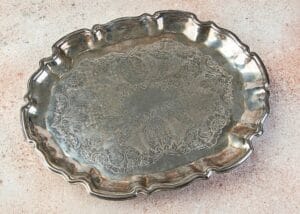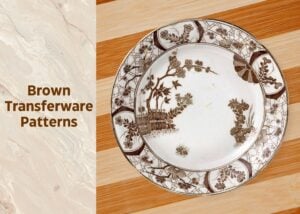I’m sure you might have many serving trays in your kitchen cabinets right now. Most people use them for parties, stack them in drawers, or barely think about them at all. But vintage trays always have all eyes on them, often breaking records for their insane value!
Some single trays might even fetch $1,500 or even more! So, before you toss or sell your antique serveware for peanuts, check this list of the rare vintage trays worth serious money and get applicable tips to find out whether you have a valuable tray.
1. Los Castillo Mexico Mixed Metals Tray

This super-rare Los Castillo tray from Taxco shows Mexican mid-century design at its best. Made from copper, brass, and silver, the tray shows abstract geometric patterns that create stunning visual depth. It measures over 21 inches and works as both art and function.
Founded by Antonio Castillo in 1939, Los Castillo became famous for these mixed-metal masterpieces. The hand-crafted techniques and warm metal finish make these popular with collectors, with large trays bringing $400-800!
2. Original Coca-Cola Serving Tray

This piece is an example of how valuable promotional pieces can be! It’s an original Coca-Cola tray from 1913 showing rich lithography promoting the “Delicious and Refreshing” drink and the beautiful “Hamilton King Girl” artwork, iconic in Coke collecting circles.
These trays were usually distributed to soda fountains and are now a coveted piece of Coca-Cola memorabilia. Original trays from the 1910s often sell for $500-2,500 or more, depending on condition!
3. French Emile Galle Inlaid Cat Motif Serving Tray

This tray is the best example of French Art Nouveau craftsmanship by master designer Emile Gallé (1846-1904). It shows detailed inlaid wood marquetry in cat designs, plus a raised border and flowing handles.
Authentic Gallé wooden trays are generally signed on the top! As a piece of quality decorative woodwork from the early 1900s, these inlaid wooden trays can make collectors pay hundreds to nearly a thousand dollars!
4. Reed & Barton Hepplewhite Engraved Tray

Silver trays are easily one of the most exotic and expensive ones, especially from renowned makers. This is one such hallmarked Sterling Silver oval tray from Reed & Barton with their iconic Hepplewhite pattern.
You can spot this design by its elegant neoclassical styling with decorative borders and refined engraving. Also, these trays have substantial weight to them, adding to value. Based on current silver prices plus the weight, this tray could be valued at $1,000-2,500!
5. Noritake Emerald & Silver Tray

This Noritake tray stands out with its dramatic geometric patterns in emerald green and silver. The ornate handles and unique curvy shape of the tray are a reflection of 1930s luxury design. When you find one in excellent condition, it can bring prices up to $800 or more.
6. Vintage Noritake Art Deco Painted Tray

This stunning oval tray shows Noritake’s Art Deco artistry from the 1920s-30s. It features a woman in a colorful, floral dress holding pink roses with hand-painted details and a silver trim.
Noritake plates from this era, with delicate edging and high-end motifs, were commissioned specifically for the American market. Art Deco trays like this one can sell for $200-500, depending on condition and patina availability of the pattern.
7. Deakin Sheffield Solid Silver Military Tray

This tray sold for over $520 for two reasons: first, it’s a hallmarked silver salver tray from Deakin & Francis, and second, it has Royal Artillery military provenance. The decorated edges, solid weight, and engraved crest show quality British silversmith work.
You’ll generally find these trays with a simple, elegant form and a beaded or rope-twist border. Deakin’s pieces from the early 1940s have additional historical weight due to wartime production and are valuable; single pieces can fetch $400-700 based on size and weight!
8. Royal Doulton Flow Blue Turkey Platter

This is a large serving tray from Royal Doulton featuring their popular flow blue, hand-painted turkey design in cobalt blue. At more than 22 inches wide, this tray works as both a Thanksgiving centerpiece and a collector’s piece.
Made during their flow blue production era, Royal Doulton made these Turkey platters especially for Thanksgiving, making them super collectible today!
9. Royal Doulton Tunis Octagonal Tray

This is an extremely rare Royal Doulton piece with their exotic 1912 pattern “Tunis.” You can identify this pattern by the Middle Eastern scene with figures in traditional robes in front of an architectural backdrop of minarets and palm trees.
These pieces generally show muted colors but fine details. Royal Doulton’s early series wares like this Tunis pattern are highly collectible, with complete pieces in excellent condition selling for $200-500!
10. Antique Sheraton Style Mahogany Inlaid Tea Tray

A serving piece featuring the 1880s English furniture-making skills, this is a Sheraton-style tea tray made from old-growth mahogany with a rich reddish grain! What makes it distinctive is the detailed, oval floral inlay in the center.
Old wooden Sheraton trays usually have a rounded board and brass side handles. They’re a good example of Victorian serving pieces, valued for size, quality, and craftsmanship, typically going for $200-600 at auction.
11. Cartlon Ware’s Spider Web Oval Tray

This Carlton Ware piece from 1950s Britain shows the company’s famous “Spider’s Web” pattern in the coveted Vert Royale green colorway and gold trim. You’ll see a hand-painted spider web and plant motifs, like brambles and bluebells, all highlighted with gold details.
Created around 1950, this design was originally attributed to artist Irene Pemberton. It remained in production only until 1961, making existing pieces rare and collectible!
12. Monterrey Western Ware Longhorn Enamelware Tray

This vintage Monterrey Western Ware tray has classic cowboy appeal with its enamelware design. The pale white metal tray shows a longhorn steer graphic with mid-century Western border designs.
Collectors like the mid-20th-century Monterrey trays for their sturdy make, bright graphics, and Western nostalgia that works well in ranch or country decor. They can sell for $100-300!
13. George Jones Majolica Serving Tray with Two Tiny Pitchers

This exquisite Victorian majolica tray set features a stunning strawberry leaf pattern in naturalistic green glazes, complete with two matching pitchers. The reason for such a small tray selling for over $230? George Jones majolica is among the most sought-after for its distinctive mottled brown and green undersurface glazing!
Identifying & Dating Antique Vintage Trays (Key Signs)
A genuine antique or vintage tray generally shows so many signs that set it apart from modern pieces or reproductions. Materials, markings, and construction elements, to name a few. Once you know what to look for in these aspects, you can easily verify authentic trays.
By Materials
Like most dishes, trays were also made from different materials in different periods. So, you can identify and date most pieces just by looking at what they’re made from. Here are the common materials you’ll see in vintage pieces:
1. Sterling Silver (925/1000 purity):
Silver and Sterling Silver have been popular for trays from the 1700s onward. Sterling silver is 92.5% pure silver mixed with other metals for strength. Fine silver is purer, but it wasn’t used much for trays.
There’s silverplate, too, a thin layer of silver mostly over cheaper metal, that became common in the early 1800s. An example would be the Sheffield plate of old England; these were made by applying a thin layer of sterling over copper.

2. Copper and Brass:
These base metals were common in the 1800s and early 1900s. You’ll often see brass trays from Victorian times and earlier periods with elaborate repoussé work. Copper pieces became popular during the Arts & Crafts movement revival around 1900, with Roycroft and Dirk van Erp museum-quality pieces.
3. Toleware:
Toleware are the dishes made of tinned iron or tin-coated iron, popular in the 1700s and 1800s. Earliest trays of toleware, especially those with stenciled, hand-painted, or lacquered works, are highly collectible. Later work (Victorian and early 20th century) has modern stenciling and less elaborate hand paintings.
4. Wood:
Wood has been used for centuries in dish-making. Older trays will be of hardwood and hand-carved, but the Mid-Century Modern pieces will likely show laminated woods like Baltic birch.
Most exotic pieces will be lacquered, such as Japanese trays and Chinese 18th- and 19th-century trays. Some pieces will also be done with inlay work using exotic materials like mother-of-pearl.
5. Mirrored Glass:
This was common for trays in the Art Deco period (1920s–1940s). You’ll often find these trays with etched glass, beveled edges, and geometric metal frames of chrome, brass, or copper.
By Markings
Always check the bottom of an old tray! That’s where you may find the most important information for identification and dating: the markings about who made it, what it’s made of, and where it was made.
- Hallmarks on Silver Pieces: Authentic silver trays must have hallmarks to guarantee the metal content. On British and European pieces, you may find symbols like the Lion Passant and the Leopard’s Head. American trays show simple marks, like “Sterling” or “925.” Silverplated pieces generally bear the “A1,” “EP,” or “EPNS.”
- Maker’s Marks: In many old trays, you may see the maker’s mark or initials. The variation in logos and scripts may help you date the piece. You can also use reference books to figure out these marks. Some famous makers are Paul Storr (England) and Tiffany & Co.
- Patent & Design Marks: Sometimes you’ll see a patent number or registered design mark on the bottom of a tray. This not only helps date the piece but also shows it was a unique design that was legally protected when it was made, like this ashtray from Mack.
- Other Stamps: Other Stamps: Starting in about 1890, the United States imposed marking the country of origin upon imported merchandise. So, old trays and platters dating from late 1800s or later may also bear country marks, like “MADE IN ENGLAND.”
By Design Elements
The look of a tray can reveal when it was made and which design movement motivated it. From floral motifs to human figures and scrolls, every design tells a different story.
Georgian Period (1714-1837):
Georgian trays usually reflect restraint and good proportions. So, early pieces are pretty plain, with simple centers with basic reed or gadroon borders. Later Georgian pieces may show Robert Adam’s influence with delicate engraving and classical motifs.
The handles usually have acanthus leaves. Feet are simple scrolls or shells.
Victorian Era Trays (1837-1901):
These are mostly fancy and elaborate. On silver trays, you’ll see heavy repoussé work (designed, hammered from the back to create raised patterns on the front).
Common features include detailed floral patterns (inlay and majolica work), fancy gallery rims (raised, decorative edges with openwork), and ornate cast feet with scrollwork.
Arts & Crafts Movement Pieces (1880-1920):

Trays from this era show honest craftsmanship and handmade quality. Look for visible hammer marks, simple clean lines, and natural designs like leaves or vines. The Kalo Shop and Roycroft made highly sought-after pieces in this style.
Art Nouveau Trays (1890-1910):
Art Nouveau pieces have flowing and curved lines and an organic-looking design without symmetry. So, there are many flowers, women with long hair, and stylized insects. Handles are usually flowing whip-like curvatures, and the overall design looks organic.
Art Deco Pieces (1920-1940):
You can spot these pieces by evident geometric patterns, stepped forms, sunburst motifs, and zigzag designs. Trays have firm lines, perfect symmetry, and often utilize new materials like chrome, Bakelite (for silver trays with handles), and mirrored glass.
Mid-Century Modern Trays (1945-1970):
MCM style focuses on function and simple, clean lines. They are found most often in warm woods like teak, especially on Danish Modern furnishings. Brushed or enamel-coated metal, glass, and heavy plastics like Melamine are also used.
Trays themselves typically have soft curves or oval forms, built-in handles that do not extend, and plain designs.
By Construction Details
Trays were put together and designed quite differently from today. Pay attention to these construction or production clues to fetch more details about when it was made!
Overall Joints:
The joint clues on old trays are important clues of age and authenticity. Look for the following:
- Dovetail joints: These interlocking wood joints have been used in quality trays and furniture since the 1700s and 1800s. They’re strong and durable, and show that the piece was handmade by skilled workers.
- Finger joints: Simpler but stronger, you will see these box-like wooden trays. They became popular in the 1800s and early 1900s for practical construction.
- Mortise and tenon joints: These also occur commonly in wood trays with separate legs or support structures, most notably in old or custom-made pieces.
- Soldered or riveted joints: Common in metal trays or items that have composite materials. Silverplate trays often have metallic parts soldered or riveted to each other.
Handles:
Check how the handles are attached. On metal trays from the 18th and 19th centuries, you’ll see hand-soldered or hand-reveted handles, often with detailed engraving or repoussé work. Also, quality trays have solid cast handles (part of the design), but cheaper ones use pressed metal handles that don’t last as well.
Handle materials can also be a good dating clue; bakelite or chrome handles indicate 20th-century trays.
Feet and Edges:
Observe the feet of old trays. Are they cast as one piece with the tray, or were they made separately and attached? Gallery rims on silver trays are typically made from separate pieces of silver and carefully soldered on.
Also, foot styles range from simple round or ball feet to fancy claw or scroll feet that tell you about the period!
For example, claw and ball feet with scrolled or gadroon feet are common on Georgian and early Victorian trays, while Art Deco trays might have sleek geometric feet with a chrome finish.
Rims:
Rims on trays are both practical and decorative. Victorian trays often have heavy, rolled, or scalloped rims with detailed patterns like gadroon edging (fluted curves).
On the other hand, Art Deco rims are usually thinner, sometimes with pierced or cut-out patterns in geometric shapes. And Mid-Century pieces may have simple, flat, or slightly raised rims made from laminated wood, metal, or plastic materials.
How to Know If a Vintage Tray Is Valuable?

Once you have finally spotted a real, authentic vintage tray, you might want to know how much it’s really worth. To do so, you will need to assess a few factors, which I’ve described below:
1. Authenticity
An antique tray’s value largely depends on whether it’s genuinely old and how old it really is. We’ve already discussed dating clues above, but real antique pieces will also show their age in ways that modern copies can’t fake perfectly!
For example, genuinely old Sterling silver and brass trays must show a varying brownish patina in the design’s recessed areas. Forced patina on new pieces is either too uniform or too dark. Over-bright or shiny metal trays are a red flag.
Similarly, the painting or designs on tin or ceramic trays are a big clue. Why? Hand-painted details show slight variations, uneven brushstrokes, or raised texture. But decals are just too uniform and may show fine cracks over time.
Lastly, most old trays (that were used) must have light wear, like scratching and fading on the bottom and edges; it proves authenticity. Toleware may also show slight chipping, too. But, where slight wear is okay, severe damage hurts the condition and, so, the value!
2. Condition
Even a rare antique tray with an exotic design can lose 50-75% of its worth if damaged. So, be on the lookout for the following signs (these mean poor condition):
- Dents, dings, or warped or bent trays (in metal pieces like silver or brass)
- Deep scratches into the material
- Heavy tarnish or corrosion (on metal pieces)
- Serious chips, cracks & crazing (in ceramic or porcelain trays)
- Severe splits and rotten wood (in wooden trays)
- Broken or missing handles and feet
- Worn or flaking paint on decorated surfaces like toleware
- Poor repairs like obvious patches, mismatched materials, or amateur fixes
- Added engravings (initials or family crests put on by later owners)
3. Rarity & Desirability
In the case of antique dishes, including trays, rarity plays a vital role in determining the worth; it is what creates exceptional value. Your tray can be rare if it meets one or more of these criteria:
- Notable maker: Pieces by collectible makers like The Kalo Shop, Roycroft, or master silversmiths like Paul Revere.
- Unique design: Special items, prototypes, or pieces produced in small numbers are always in greatest demand.
- Completes a set: The last piece to a valuable tea, coffee, or bar service makes it irreplaceable to collectors trying to complete their collection.
- Limited production: Pieces from limited editions, promotional series, or special commissions that rarely appear on the market are quite rare. That Coca-Cola tray, for instance!
4. Provenance & History
The ownership history of a tray can also enhance its value if the tray belonged to well-known people, was used at noteworthy events, or holds authentic, meaningful history.
Documentation, such as paper traits, true photographs of use, or invoices/receipts of sale from famous estates, can transform even a common tray into a historic piece of substantial value.
Note: This article is intended for informational, educational, and entertainment purposes only. Some images are illustrative and may not represent actual brands, products, or related entities. All trademarks, product names, brand logos, packaging, and other intellectual property referenced remain the exclusive property of their respective owners. Any brand mentions or references are provided solely for descriptive and educational context and do not imply any formal or commercial association.




